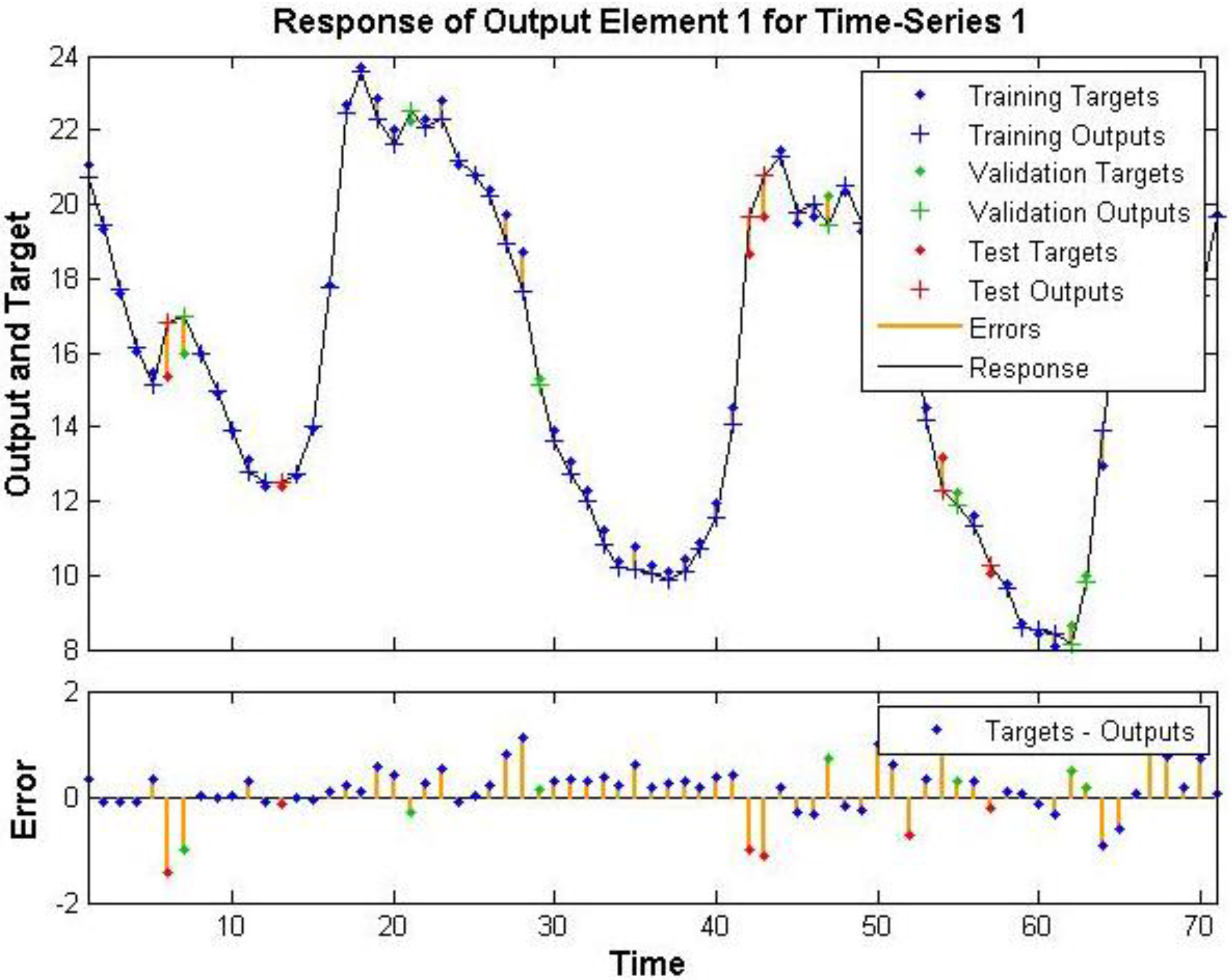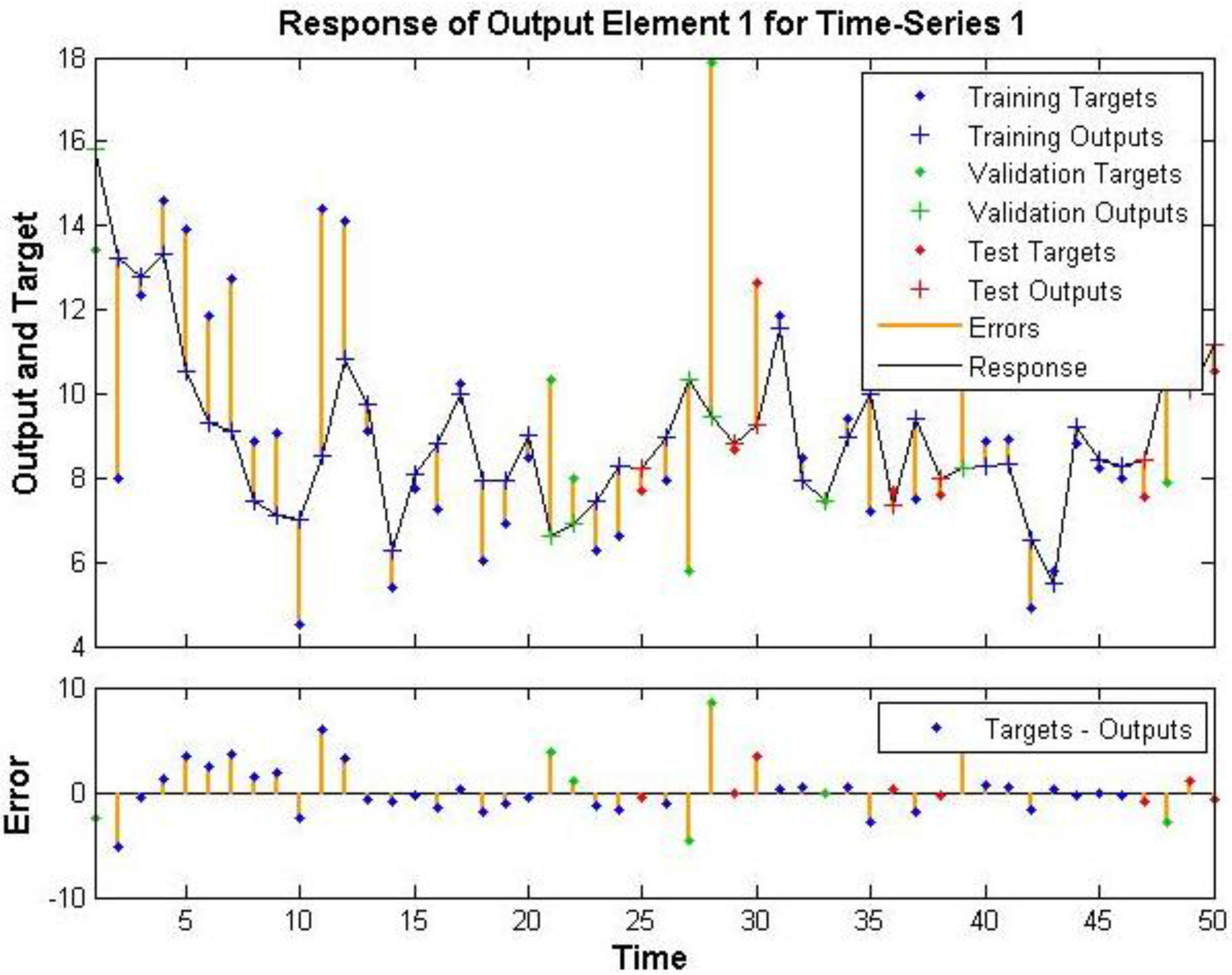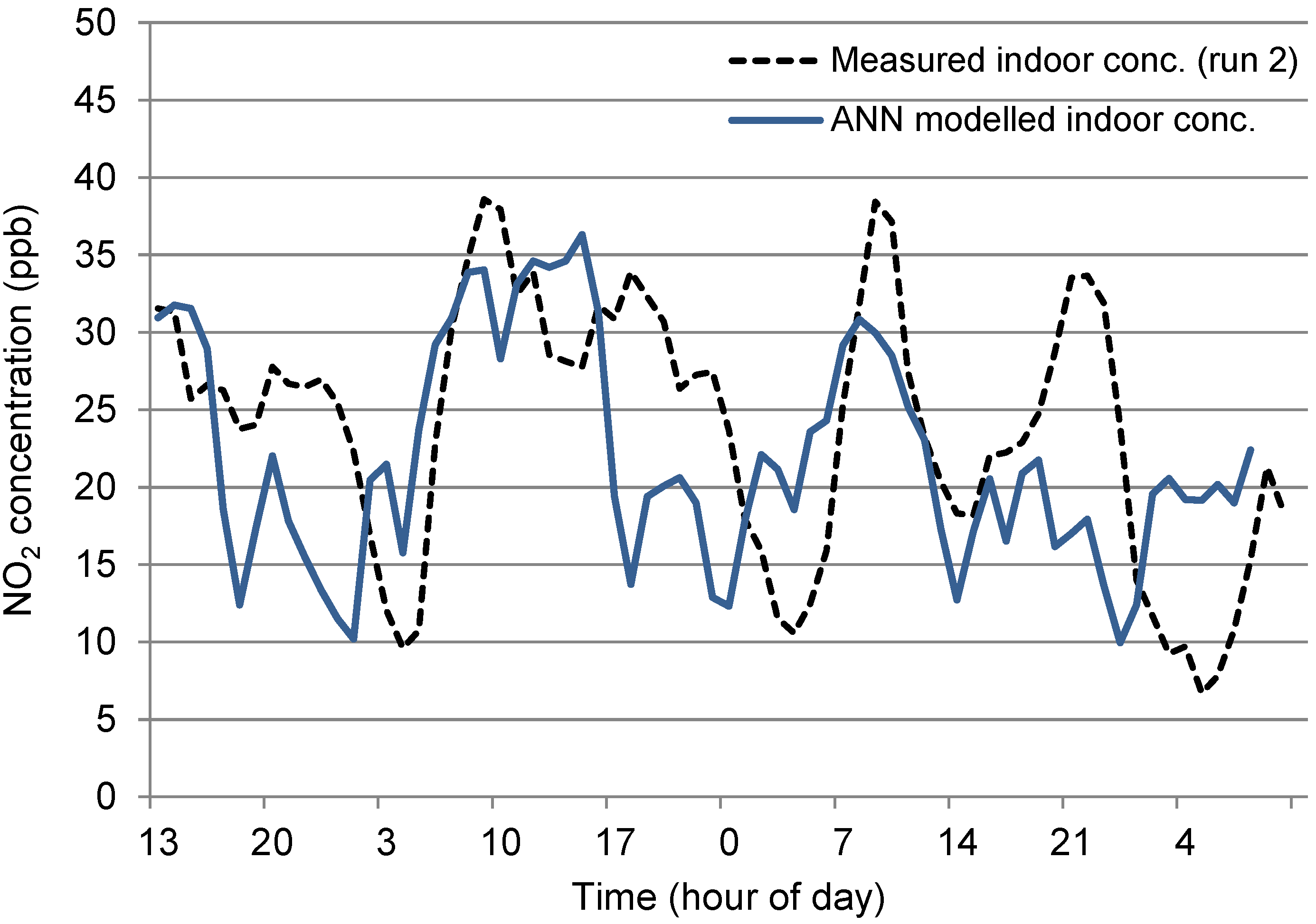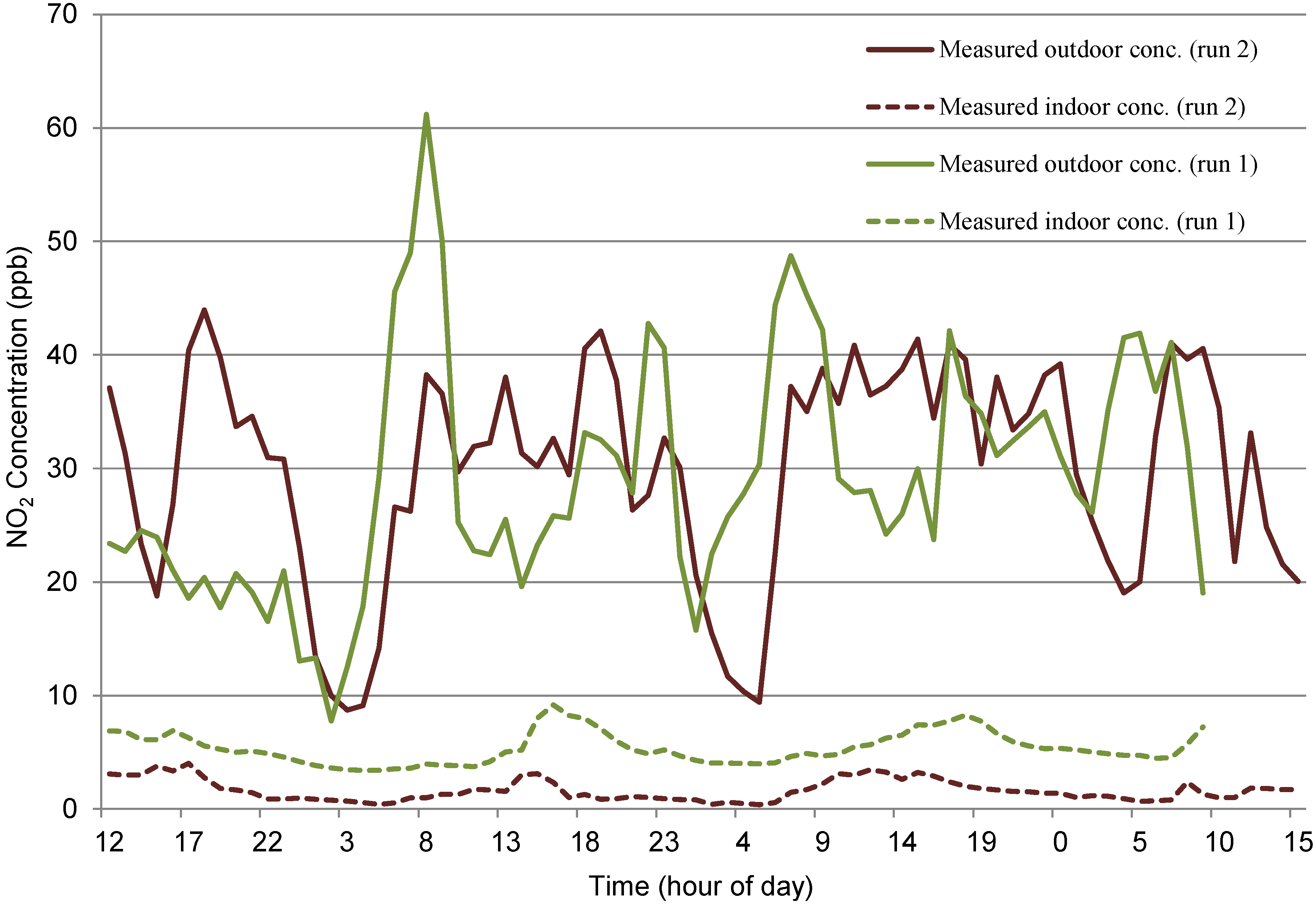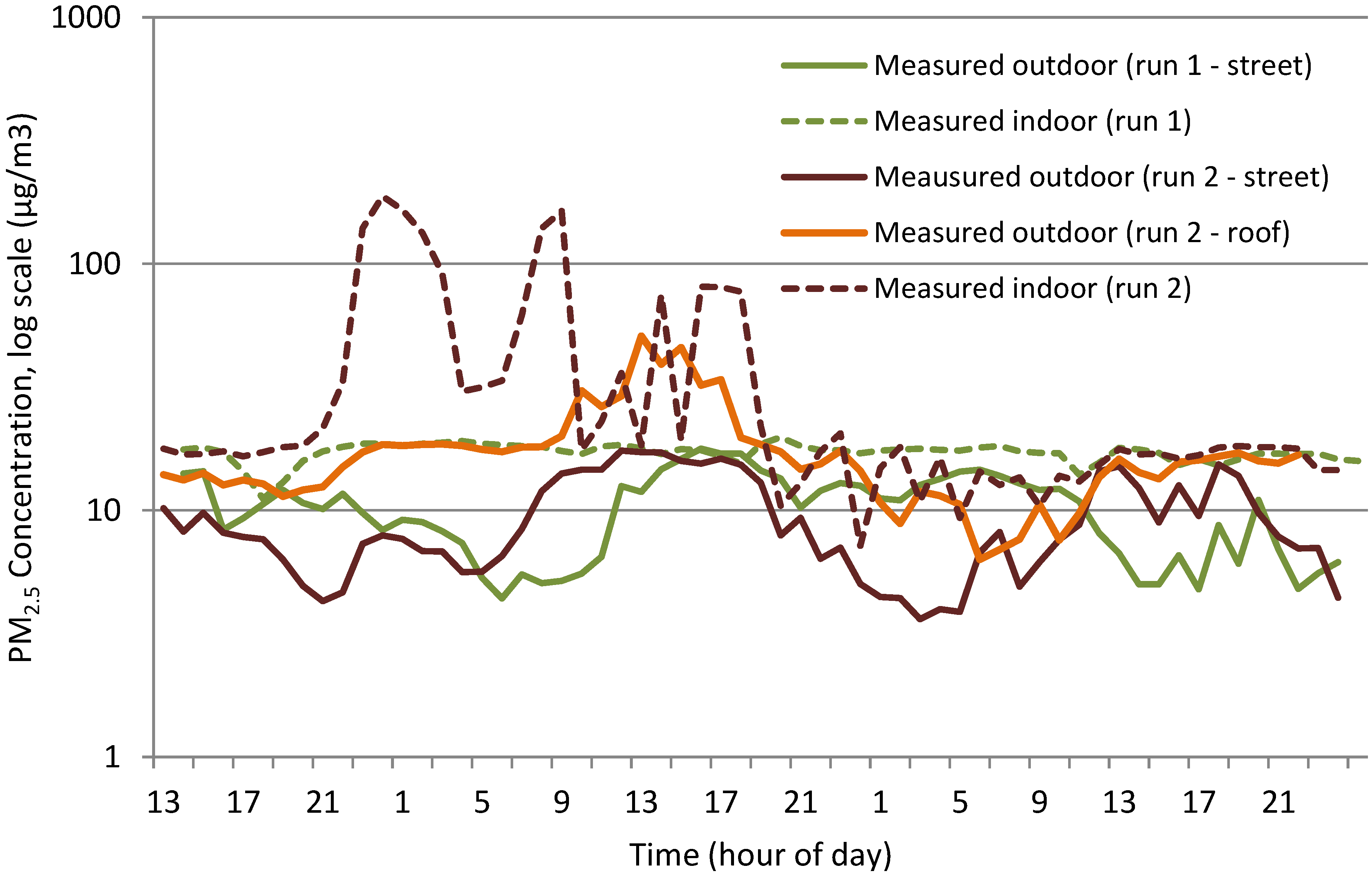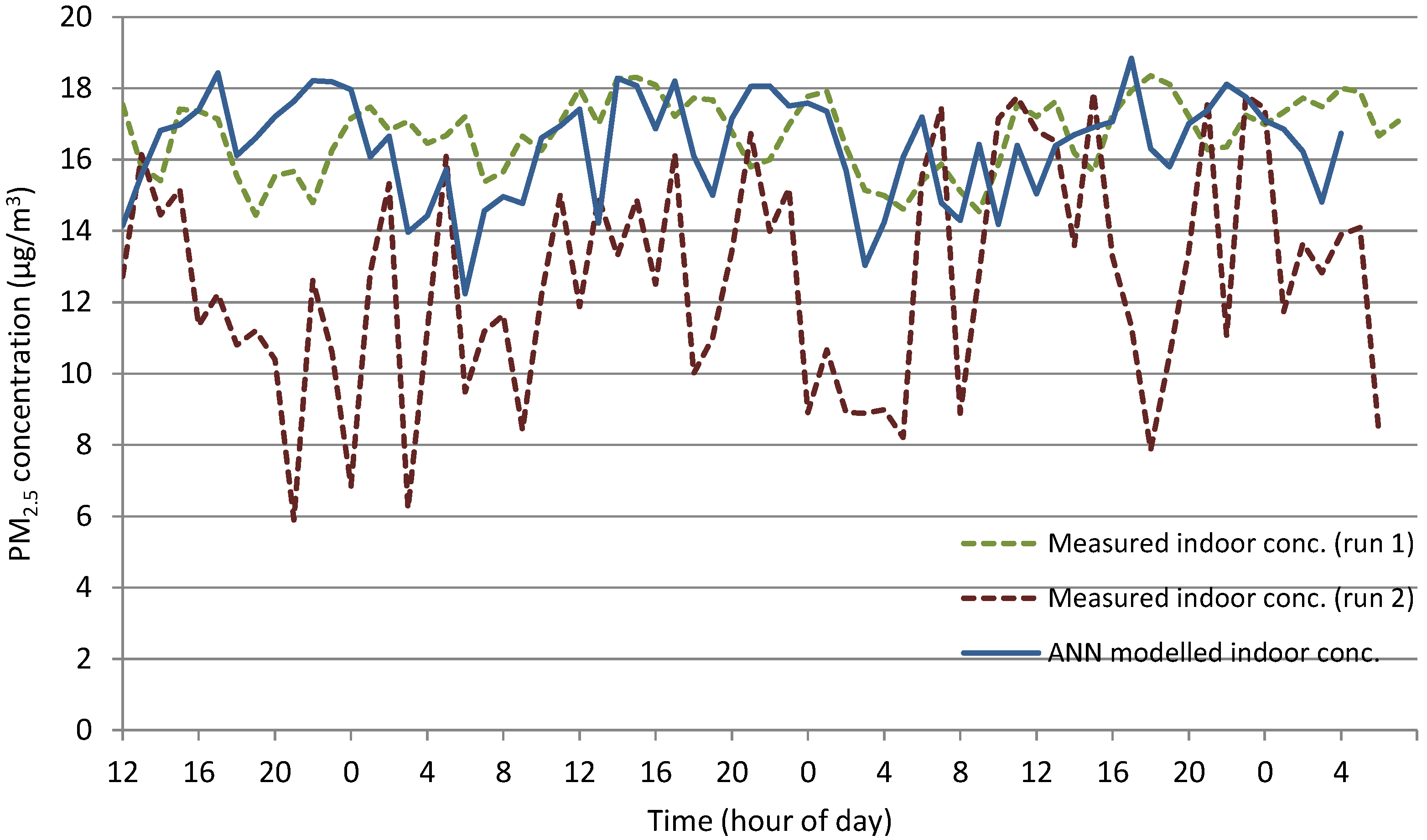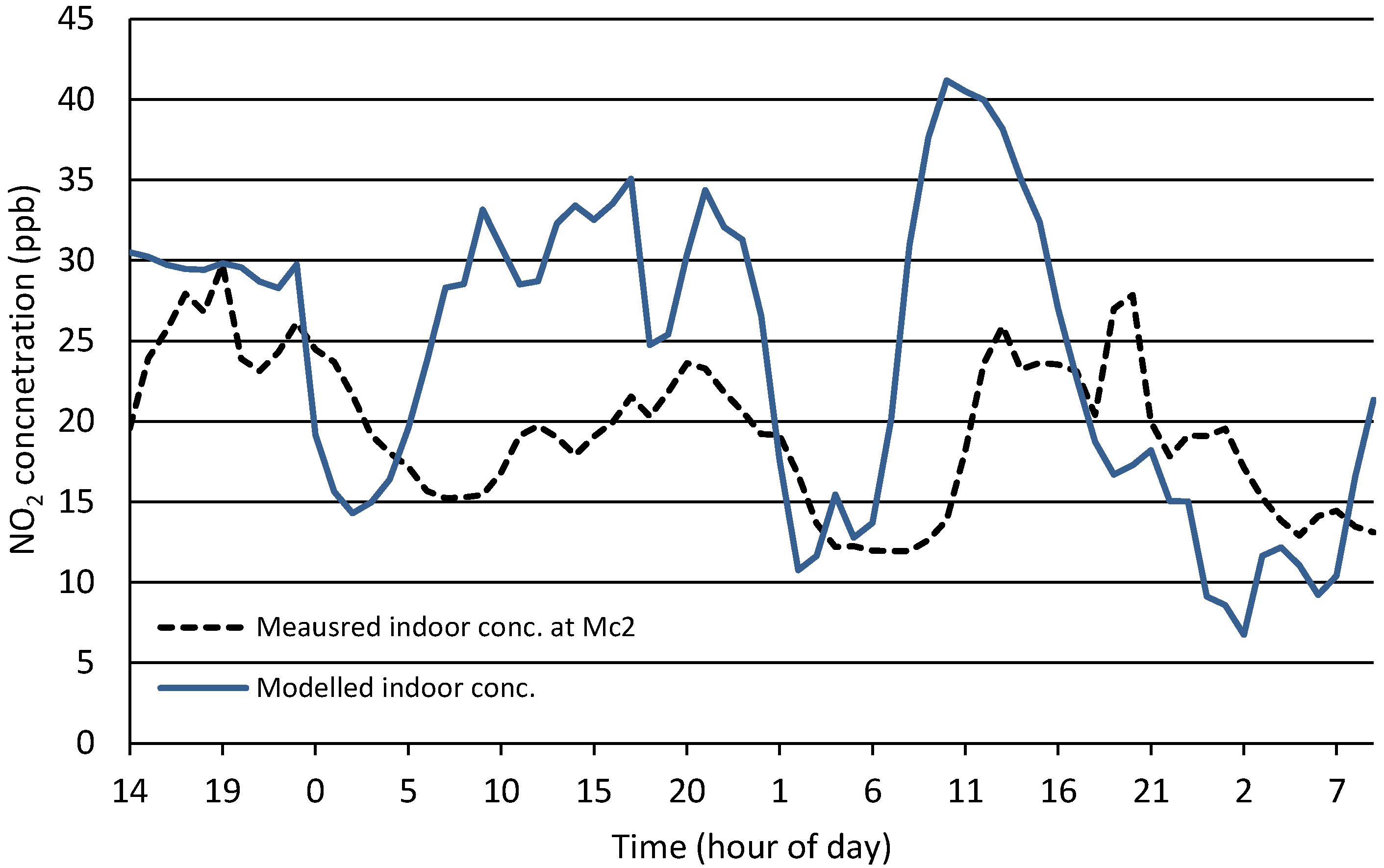1. Introduction
The United Nations Urban Environment Unit associates up to one million premature deaths annually to urban air pollution and over 90% of the air pollution in developing cities has been linked with poor quality vehicles [
1]. Illnesses to which poor outdoor air quality has been attributed include: cancers of the bladder, kidney, stomach, oral cavity, pharynx and larynx, multiple myeloma, leukaemia, Hodgkin’s disease, and non-Hodgkin's lymphoma [
2].
The predictive models developed in this research were based upon measured concentrations of PM
2.5 and NO
2 inside and outside commercial buildings in Dublin, Ireland [
3]. A study into air pollution in 26 cities across Europe [
4] noted that Dublin, with a population of approximately 1.2 million [
5] in an area of 290 km
2, has comparatively low concentrations of air pollutants, such as NO
2 and PM
2.5, which were within EU limits. However, a recent report by the Irish Environmental Protection Authority (EPA) stated that NO
2 and particulate matter were the two pollutants of most concern in Ireland [
6] which may be due to the high respiratory and cardiovascular mortality and morbidity rates in Ireland compared to most of the rest of Europe [
1,
7]. Although these illnesses may not be directly caused by poor air quality, they may be worsened by it. In particular, respiratory illness (such as asthma and bronchitis) is the third most reported illness in Ireland after cardiovascular and musculoskeletal diseases. Sufferers of respiratory illnesses are a high-risk group with respect to air quality and are adversely impacted with declining air quality faster than the general population. For example, the loss of working hours due to asthma has been estimated at three days per adult and is estimated to cost the Irish economy €16.6 million [
8]. Statistically significant increases in hospital admissions have been recorded with increased periods of NO
2 in Athens [
9], which concur with a calculated 0.5% increase expected for every 10 μg·m
−3 increase in NO
2 concentrations [
10]. Oxides of Nitrogen (NO
x) and PM
2.5 put strain on the cardiovascular and respiratory systems, thereby aggravating illness, and so any reduction in concentrations, regardless of limit values, should benefit a population with high rates of such illnesses.
Currently, air quality limits in Europe only cover outdoor environments, yet the quality of indoor air is an essential determinant a person’s well-being, especially since the average person spends more than 90% of their time indoors [
11,
12]. Indoor health was not considered when comparing European PM
2.5 and NO
2 legislative concentrations, yet poor indoor air quality has been associated with symptoms like headaches, fatigue, trouble concentrating, and irritation of the eyes, nose, throat and lungs, all of which effect the productivity of a workforce [
2,
13,
14,
15]. Most cities now have a number of ambient air quality monitoring stations but studies have found that such ambient outdoor measurements can prove to be a poor predictor of personal work-day exposure, with the higher personal exposures often due to increased indoor concentrations of the measured pollutant. For example the EXPOLIS study found median correlations of personal exposure and outdoor monitoring of PM
2.5 ranging from 0.39 to 0.91 across Europe [
16,
17]. The link between indoor and outdoor air quality in commercial buildings was also studied by Mosqueron
et al. [
18], who found a correlation of
r = 0.05 when comparing urban background concentrations with in-office concentrations for NO
2 and PM
2.5 in Paris. Zeger
et al. [
19] also previously found that fixed site monitoring was not ideal for calculating exposure. A European wide study known as AIRMEX reported that indoor concentrations of Volatile Organic Compounds (VOCs) and PM
10 in two Dublin city centre offices in May 2007 were often higher than outdoor concentrations [
20].
There has been much recent research into the use of different modelling approaches to predict a variety of different outdoor air pollutant concentrations at higher resolutions for specific locations in the urban environment to improve upon the relatively sparse ambient monitoring data that is normally available, see for example [
21,
22,
23,
24,
25]. However, there have been much fewer studies that have tried to predict indoor air quality from the local outdoor conditions in such an urban environment. Hence, this research aims to provide a methodology based upon modelling which can use publically available data from fixed site monitoring stations in order to predict indoor air quality more accurately. Predictions are made using two modelling techniques. Initially, Artificial Neural Networks (ANN) models were developed to determine the dynamic relationship between the measured outdoor and indoor air quality of several monitored buildings. The Personal-exposure Activity Location Model (PALM) model [
26,
27] was then used to predict the outdoor air quality at any particular building in the city and thus provide an input into the ANN models to predict indoor air quality. This approach ultimately provides predicted indoor air concentrations, which can then be used to determine urban workers’ pollutant exposures more rigorously. This data could then be linked to future epidemiological studies, for example the incidence of respiratory illnesses of those who work and/or live in the city centre.
2. Experimental Section
2.1. Experimental Data
As part of a wider research project, summarized in Challoner and Gill [
3], ten commercial buildings were chosen for air quality monitoring, all located along busy street canyons in Dublin’s city centre. Three of these buildings were chosen for this more detailed study which has developed ANN based models to predict indoor air quality from of outdoor air quality measurements, as discussed later. These buildings were chose due to their proximity to each other, on one side of a heavily trafficked inner city street (Pearse Street), in addition to having different ventilation and use attributes: two are mechanically ventilated and the third is naturally ventilated (see
Table 1 for details). The indoor monitoring at the first of the mechanically ventilated buildings (M
c2) took place in a small office space (2.9 m × 4.2 m plan and 4.5 m high) while the indoor monitoring at the second mechanically ventilated building (M
c3) was in a large open gallery space (room volume 702 m
3). The ventilation systems for both buildings were controlled upon a set-point temperature and humidity matrix rather than on a specific number of air changes per hour. The naturally ventilated space (N
t2) was a medium sized office (9.7 m × 4.0 m plan and 4.0 m high) with six occupants. PM
2.5 and NO
2 concentrations were measured simultaneously indoors and outdoors of the different buildings (shops and offices). Outdoor concentrations were measured in two locations either at ground level outside the building or at the air intake of the building’s ventilation system. For example, for the first monitoring period (Run 1) at M
c2, outdoor air quality was monitored at roof level whilst for Run 2 outdoor air quality was monitored at ground level (as detailed in
Table 1). For Run 2 at M
c3 an extra set of monitors was resourced to enable outdoor monitoring to be conducted at roof and ground level simultaneously to the indoor monitoring. Both indoor and outdoor measurements were taken at a height of 1 to 1.5 m above ground level.
Table 1.
Monitoring sites summary and details.
Table 1.
Monitoring sites summary and details.
| Site No. | Building Type | Vent. Type | Age (Years) | Opening (h) | Run 1 | Run 2 |
|---|
| Nt2 | Office | Nat. | ~120 | 10 a.m.–6 p.m. | 26–29 April 2011 | Ground | 27 June–1 July 2011 | Ground |
| Mc2 | Office | Mech. | ~5 | 8 a.m.–6 p.m. | 6–9 July 2010 | Roof | 12–15 July 2010 | Ground |
| Mc3 | Shop | Mech. | ~5 | 8 a.m.–8 p.m. | 13–16 December 2010 | Ground | 27–31 March 2011 | Roof/Ground |
The indoor and outdoor measurements of PM
2.5 were measured by two identical Haz-Dust monitors (Environmental Devices Corporation, EPAM-5000, Haz-Dust) set at a flow rate of 2 L·min
−1. For NOx, two Teledyne, M200 monitors (which work on the principle of chemiluminescence) were used to measure NO and NO
2: a M200E model was used for outdoor monitoring with a limit of detection of less than 1 ppb and a M200EU model used for indoor monitoring with limit of detection of 0.05 ppb. Both monitors were set to a flow rate of 0.479 L·min
−1. Weather data were sourced from the national meteorological (Met Eireann) monitoring stations located in Phoenix Park and Dublin Airport. Full details of the results are contained in Challoner and Gill [
3].
2.2. Artificial Neural Network Model
An artificial neural network (ANN) is a robust non-linear computational method which was originally designed to emulate biological nervous systems but has since been applied to many fields of study including air pollution [
28,
29]. ANNs do not have pre-defined assumptions such as prior hypotheses regarding variable relations; they have a low sensitivity to error term assumptions and a high tolerance to noise. ANN makes use of a complex combination of weights and functions to convert input variables into an output (prediction). It can be employed to examine relationships in complex non-linear data sets in the same way as conventional statistical techniques, but without many of the parametric restrictions about the nature of the data relationships. ANNs use previously collected times series data (e.g., indoor concentrations and outdoor meteorological data in the case of this research), that the model is being developed to predict. In the current study, the Levenberg-Marquardt Algorithm [
30,
31], a type of feed-forward ANN, is utilised for the modelling procedure Equation (1). This algorithm provides a numerical solution to the problem of minimising a function, generally nonlinear, over a space of parameters of the function. The Levenberg-Marquardt Algorithm (LMA) interpolates between the Gauss-Newton Algorithm [
32,
33] and the method of gradient descent, which is a first order optimisation algorithm.
where:
The ANN has an inputs layer, at least one neuron layer (although usually a group of interconnecting neurons are present) and an outputs layer [
34]. Using input data the ANN is “trained” by inputting a set of “target” values (in this case the indoor air quality concentrations), which the ANN should achieve by processing the input data. Once trained and tested, the ANN can be applied widely in a number of applications because of their fascinating characteristics of robustness, fault tolerance, adaptive learning ability and massive parallel processing capabilities. For example, ANNs have been used for time series prediction of air pollution levels at monitoring station locations [
35], at street level [
24,
36] and at locations of particular interest such as road intersections [
25].
2.3. Prediction of Outdoor Levels using PALM Model
The PALM-GIS model [
27] was used to predict the outdoor pollution levels at the locations of the test sites. The PALM-GIS model uses custom Python scripts to integrate various air dispersion models (such as the Operational Street Pollution Model [
37], the General Finite Line Source Model [
38] and Gaussian Dispersion models) with a Geographic Information Systems (ArcGIS) platform; the advantage of this solution is that scripts are used to automate the time-consuming and complex GIS workflows, such as the iteration of the modelling procedure for different modelling tests and weather conditions. ArcGIS also allows the user to create a custom user script tool by coding the workflow and the succession of commands. The custom tool can then be easily called and used by any ArcGIS user. This integration aims to provide the researchers, Local Authorities and others with a tool to calculate the concentration levels of air pollutants and to correlate them with other thematic layers, such as land use and population density, in order to link localized peaks in air pollutants with particular activities. As such, the following outcomes were obtained by using dedicated ArcGIS workflows and tools:
- (1)
Modelled background concentration levels;
- (2)
Modelled traffic related concentration levels in urban and sub-urban environments;
- (3)
Modelled industrial sources related concentration levels;
- (4)
Modelled domestic sources related concentration levels;
The concentration levels were then combined in ArcGIS in order to obtain total concentration levels at the test locations for the periods during the different monitoring runs.
Data for PALM Model
The following datasets were used in the models described in the previous section:
- (1)
Weather data: weather data at an hourly time step was obtained from Met Eireann for the Dublin Airport synoptic stations (located 8 km from the city centre on the north side of the city) for: wind speed, wind direction, temperature, humidity, dew point, atmospheric pressure, rainfall, solar radiation and atmospheric stability classes.
- (2)
NO2 and PM2.5 data: daily average NO2 and PM2.5 concentration levels were sourced from the monitoring stations in the Great Dublin Area, classified as “Background” stations by the Irish EPA.
- (3)
Traffic data: the traffic data used for the OSPM (Operational Street Pollution Model) model [
37] was obtained from Dublin City Council (DCC). DCC monitors traffic continuously at different traffic intersections (critical junctions) around the city. The time resolution is was generally 15 min aggregate data. For the motorways, Port Tunnel,
etc., information is collected by The National Road Authority (NRA) and then stored/archived by DCC.
- (4)
Building geometry and road network: streets and buildings data for the Great Dublin Area were supplied by Dublin City Council in GIS format; as such the initial main challenge in using OSPM in this project is to import these street and buildings data into the environmental software. The buildings and road network were imported in OSPM using AirGIS [
39].
2.4. Forward Prediction of Indoor Air Quality using Artificial Neural Networks
The training of open networks as previously discussed is a useful method to check if hidden connections between indoor and outdoor air quality and other meteorological factors can be found, therefore increasing the prediction power over that of a simple regression. While this is useful, the real power in the use of an ANN lies in forward prediction. The forward prediction model used the original ANN run at a specific site to train a network as previously discussed. This network was then closed, meaning that no more target (i.e., indoor) data could be provided. Once the network was closed, new inputs for the second run, i.e., the outdoor concentrations and meteorological conditions, were used in conjunction with the previously trained network to predict the new indoor concentrations.
The add-on code required three input files (original inputs, original targets and inputs for forward prediction model). Changes to the input delays or hidden networks were specified at this point if required, in addition to changes in the amount of data used for training, validation and testing of the open network. At this point the network was trained using the first run of data, as was done in the previous sections. Once the original network was trained, the code automatically closed the network, which means that no more target data (i.e., indoor concentrations) would be provided. The new input data, as calculated in the previous section, for forward predictions was then fed into the trained network and the model predicted the response of the indoor air quality concentrations due to fluctuations in outdoor air quality and weather data.
5. Discussion
5.1. Forward Prediction Ability
The ANN modelling approach does show an ability to predict mean indoor NO2 exposure values from outdoor air quality data and ambient meteorological conditions for a given building, providing there is no other significant indoor production or degradation process occurring between the period where data is collected to train the network and the period for which the model is being used to make predictions. The ability of the model to predict PM2.5 however is much reduced. Improved predictions should be found if longer monitoring periods can be used to train the model, particularly if these include more variation in indoor and outdoor conditions. The ANN did show the ability to adapt to variations in the relationship between indoor and outdoor air quality. For example, at the end of run 1 at Mc3 a change in the air pressure caused the relationship to change between indoor and outdoor which was similar to the relationship fluctuation seen in run 2. As the network was trained with run 1, the resultant forward prediction ability for indoor concentrations during run 2 was strong. This was not the case however, at Nt2 where the run 1 data upon which the network was trained, did not seem to include the full dynamics between outdoor and indoor air quality that occurred during the second run. The relationship seen in run 2 showed a stronger sink between outdoor and indoor for NO2 with the results that the trained model was unable to correctly predict the level of indoor concentrations during run 2.
The ANN models also proved to be not so flexible when trying to transfer their indoor air quality predictions to other inner city buildings of apparently similar characteristics (on which they had not be explicitly trained) which indicates a significant limitation to the approach of this type of air quality modelling, based upon such limited monitoring data at least. It would obviously be infeasible to carry out detailed indoor and outdoor air quality monitoring for all buildings of interest in order to develop appropriate models.
However, once trained, these networks can be used to predict future longer-term averages in indoor air quality concentrations in the monitored buildings using updated outdoor concentrations provided by the PALM-GIS model and weather data from ambient stations. In Ireland, the EPA does not monitor PM2.5 data at hourly intervals therefore forward prediction would only be applicable for use in conjunction with NO2, which is available in hourly resolution. However, the testing of PM2.5 for forward prediction using data from Nt2 showed a poor result indicating that even if hourly data was available it is unlikely to predict indoor pollutant exposure sufficiently.
It is interesting to note that interviews with building occupants showed an enthusiasm to learn about their air pollutant exposure levels. Hence, a future application of this work could be online tool or phone application to give building occupants indicative indoor concentrations. This would require a robust data base of generalized building types trained with a forward prediction model which could be linked with an online tool. Linking with real time traffic information and metrological data has the potential to give real time data feeds. Such a generalised model could realistically be fully developed for NO2 but maybe not for PM2.5 due to the model’s apparent poor ability for forward prediction. However, the WHO has previously stated that NO2 is strongly correlated with other toxic traffic related pollutants, such as benzene and toluene. Therefore, NO2 could be used as a surrogate to indicate concentrations of various other pollutants.
5.2. Implications to Public Health
The quality of air is rarely, if ever, considered when choosing a place of work, yet poor air quality will significantly affect the quality of health enjoyed by the employees. The average human inhales 20,000 litres of air daily or 14 litres per minute increasing to 50 litres per minute under intense physical exercise [
40]. Over the past two decades strong evidence has been gathered showing links between fine particulate matter and respiratory/cardiovascular illnesses [
14,
41,
42,
43,
44,
45]. These illnesses include asthma, acute bronchitis, lung cancer, damage to nasal passages and respiratory tract inflammation. Previous research [
46], noted that even a 2 µg m
−3 difference in average exposure to PM
2.5 over a life time in Dublin can reduce the life expectancy of a person by 6 months. Recent indoor studies have also provided evidence of effects on respiratory symptoms among infants at NO
2 concentrations below the annual mean 21 ppb limit [
47]. Hence, the modelling approach as presented in this research can help to provide information as to realistic daily and longer-term exposures and thereby feed into debates surrounding new indoor air quality legislation.
The data presented here was part of a wider research project (see [
3]) that was carried out on 10 inner city buildings (five mechanically ventilated, five naturally ventilated). This found that the indoor air quality in several of the buildings showed an exceedance of the WHO annual mean 21 ppb guideline value for NO
2 [
48] during averaged working hours, but no site exceeded the maximum 1 h NO
2 concentration WHO guideline limit of 105 ppb. In general, naturally ventilated buildings showed lower NO
2 concentrations indoors, than the mechanically ventilated buildings. The highest maximum 1 h values recorded indoors were at M
c3 (run 2) of 38.6 ppb. An interesting feature from the indoor data at many sites was that the indoor NO
2 concentrations only dropped to 10 to 12 ppb, particularly inside the mechanically ventilated buildings, even though outdoor concentrations had dropped to much lower levels. Outdoor roadside NO
2 concentrations at the 10 monitored sites had an average concentration at 22.4 ppb and a max 1 h concentration of 79.6 ppb in heavily trafficked areas of Dublin city centre. For comparison, the European average for trafficked sites in 2008 was found to be 43.2 ppb, almost double the average roadside concentration found in Dublin [
49]. Equally, a study in Osaka, Japan found average winter concentrations of NO
2 of 53 ppb and summer time concentrations of 49 ppb for urban monitoring.
For PM
2.5 there is no outdoor 1 h or daily limit under EU legislation currently, but an annual mean limit of 25 μg·m
−3 has been set out by the CAFE directive [
50]. The mean indoor PM
2.5 concentration in the naturally ventilated buildings during working hours was 24.2 ± 8.5 μg·m
−3, compared to 18.9 ± 6.2 µg·m
−3 during non-working hours. Equally, in the mechanically ventilated buildings the mean indoor PM
2.5 concentration during working hours was 23.7 ± 9.2 µg·m
−3, compared to 20.9 ± 12.0 µg·m
−3 outside working hours. Five sites were found to exceed the annual mean 25 µg·m
−3 PM
2.5 objective value during working hours.
This combined modelling approach of developing trained ANNs for specific inner city buildings, which are then fed by realistic outdoor concentrations at that street in the city from the PALM-GIS model could be used to provide a reasonable estimate of long-term indoor air quality in such workplaces. Such data can then be used to make assessments of public health given the amount of time an average person spends indoors at their workplace; it has been estimated, for example, that up to 75% of daily NO
2 exposure occurs during working hours [
51]. This modelling approach could also be used to assess how different building types, sites and other operational characteristics may act to either enhance or mute the ingress of outdoor pollutants into such working environments, which will be of interest to urban planners, architects and engineers in the future.
6. Conclusions
The ANN predictions showed stronger predictive abilities for indoor NO2 concentration fluctuations when compared to PM2.5 using outdoor concentrations, with meteorological variables. This was attributed to the more uniform NO2 diurnal patterns which are influenced by meteorological variables such as global radiation to a much greater extent than PM2.5.
Use of the forward predictions for NO2 showed an ability of the ANN model to accurately predict mean exposure values as long as similar meteorological conditions occurred to the data set that the model was trained upon. If longer monitoring periods, which covered a variety of meteorological conditions and indoor/outdoor relationships, were used in order to initially train the network, errors may be reduced.
Unfortunately, it was found that the ANN could not use a network trained using data from one site to predict indoor concentrations at another site. This was due to the differences in various buildings relationships between indoor and outdoor concentrations. Hence, its use as a predictive model may be somewhat limited and only applicable to sites which have gathered detailed indoor and outdoor air quality data previously.
Finally, the study has shown that the greatest influence on the quality of indoor air for the majority of buildings was the quality of outdoor air. Hence, once outdoor air is at a standard which protects human health, the implication is that indoor air will more than likely be close to this level. The monitoring undertaken for this paper was short term in nature but indicates that the air quality in Dublin is within EU limit values.
